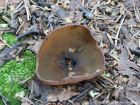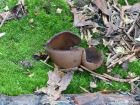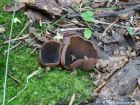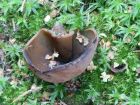Fruiting body upper (hymenial) surface is reddish brown to olive or yellowish brown and smooth. The outer (lower) surface is similar in colour, sometimes with more purplish tones, and may appear finely granular or mealy, especially near the margin. The fruit body is shallowly cup-shaped, often compressed, lobed, or irregular, with a thin, sharp margin that turns black when dry. It is sessile, attached at a narrow central point. The flesh is thin, brittle, and brown to whitish. Spore print white.
Microscopic Features: Spores measure 17–22 x 7–10 µm including ornamentation. They are subfusiform to fusiform at maturity. Initially smooth, they soon become verruculose to verrucose with fine isolated warts measuring 0.25–0.5 µm in height. The spores often develop broad, flattened apical caps and are typically 1- or 2-guttulate, especially during development.
Synonyms: Phylloscypha phyllogena and Peziza badioconfusa are synonyms.
Phylloscypha phyllogena on the the MushroomExpert.Com Web site.
Many mushrooms are poisonous, and some can be lethally toxic. Distinguishing between edible and poisonous mushrooms can be very challenging. Therefore, we strongly advise against consuming wild mushrooms. This website does not contain any information about the edibility or toxicity of mushrooms.
Although efforts have been made to ensure accuracy on this website, the information may contain errors and omissions. Therefore, all content provided is for educational and informational purposes only and should not be relied upon or used as a basis for consuming any plants or mushrooms.
External links are provided for reference only. We do not endorse or take responsibility for the content, advice, or products found on these sites or in any advertisements shown on this website.



